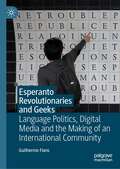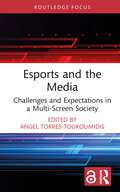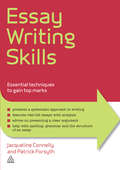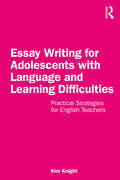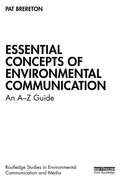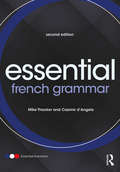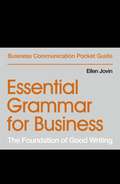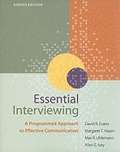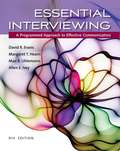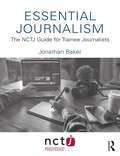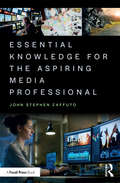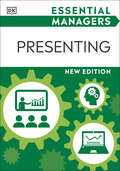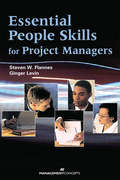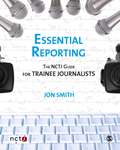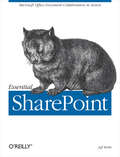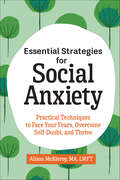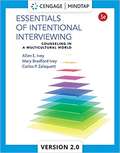- Table View
- List View
Espanol medico y sociedad: Un libro para estudiantes de espanol en el tercer ano de estudios (Revised Edition)
by Alicia GiraltEspanol medico y sociedad/ Medical Spanish and Society is an innovative textbook that fulfills the needs of upper-division Spanish students who are pursuing degrees in the health professions, plan to become medical interpreters or just want to improve their proficiency in the language. It provides multiple opportunities to learn vocabulary related to the medical field, reviews hard-to-understand grammatical concepts, describes health-related cultural competence and presents opportunities to discuss issues of concern about the health of Hispanic communities in the US and abroad.
Esperanto Revolutionaries and Geeks: Language Politics, Digital Media and the Making of an International Community
by Guilherme FiansThis book explores how Esperanto – often regarded as a future-oriented utopian project that ended up confined to the past – persists in the present. Constructed in the late nineteenth century to promote global linguistic understanding, this language was historically linked to anarchism, communism and pacifism. Yet, what political relevance does Esperanto retain in the present? What impacts have emerging communication technologies had on the dynamics of this speech community? Unpacking how Esperanto speakers are everywhere, but concentrated nowhere, the author argues that digital media have provided tools for people to (re)politicise acts of communication, produce horizontal learning spaces and, ultimately, build an international community. As Esperanto speakers question the post-political consensus about communication rights, this language becomes an ally of activism for open-source software and global social justice. This book will be of relevance to students and scholars researching political activism, language use and community-building, as well as anyone with an interest in digital media more broadly.
Esports and the Media: Challenges and Expectations in a Multi-Screen Society (Routledge Focus on Digital Media and Culture)
by Angel Torres-ToukoumidisThis book takes a multidisciplinary approach to the question of esports and their role in society. A diverse group of authors tackle the impact of esports and the ways in which it has grown within the entertainment industry around the world. Chapters offer a coherent response to the following questions: What role do esports play in the entertainment industry? What communication skills can be learned through esports? What do the media gain from broadcasting esports? What is the relationship between social networks and esports? What are the main marketing strategies used in esports? What effect does communicative globalization have on the development of esports? What is the relationship between merchandising and esports? What do communication experts think about esports? Offering clear insights into this rapidly developing area, this volume will be of great interest to scholars, students, and anyone working in game studies, new media, leisure, sport studies, communication studies, transmedia literacy, and digital culture.
Esports and the Media: Challenges and Expectations in a Multi-Screen Society (Routledge Focus on Digital Media and Culture)
by Angel Torres-ToukoumidisThis book takes a multidisciplinary approach to the question of esports and their role in society. A diverse group of authors tackle the impact of esports and the ways in which it has grown within the entertainment industry around the world.Chapters offer a coherent response to the following questions: What role do esports play in the entertainment industry? What communication skills can be learned through esports? What do the media gain from broadcasting esports? What is the relationship between social networks and esports? What are the main marketing strategies used in esports? What effect does communicative globalization have on the development of esports? What is the relationship between merchandising and esports? What do communication experts think about esports? Offering clear insights into this rapidly developing area, this volume will be of great interest to scholars, students, and anyone working in game studies, new media, leisure, sport studies, communication studies, transmedia literacy, and digital culture.The Open Access version of this book has been made available under a Creative Commons Attribution-Non Commercial-No Derivatives 4.0 license: https://www.taylorfrancis.com/books/oa-edit/10.4324/9781003273691/esports-media-angel-torres-toukoumidis
Essay Writing Skills
by Mark Connelly Patrick Forsyth Jacqueline ConnellyWriting essays is a major part of many further education courses. In coursework assignments, dissertations and exams, a well-written essay can make the difference between a pass and a fail. Essay Writing Skills offers practical and proven ways to maximise your success in all aspects of essay writing. From planning your first essay to assessing primary and secondary sources, it will help you to write in a systematic way that presents a convincing and academically sound argument. A comprehensive guide, it provides guidance and advice on good research techniques, grammar and accuracy, creating an essay plan and correctly citing your sources.Also including a range of real life example essays and insider knowledge on how your essays are assessed, Essay Writing Skills is an indispensible source of advice, making the writing process clear and manageable to help you improve the quality of your written work.
Essay Writing for Adolescents with Language and Learning Difficulties: Practical Strategies for English Teachers
by Kim KnightEssay Writing for Adolescents with Language and Learning Difficulties is a step-by-step guide for educators teaching secondary students with language difficulties how to write an English essay and, more importantly, how to do this on their own. Essay writing is one of the most difficult skills that secondary school students need to develop, though there are limited resources available to support these students and their teachers. Based on research into language disorders in adolescence and language processing, the strategies in this book are easy to apply and represent a scaffolded and sequenced approach to teaching essay writing. The book's structure encourages students' skills and confidence to be developed gradually, each chapter building on the last, beginning with the early stages of text analysis and progressing through to writing a complete essay. While written with students with language difficulties in mind, the strategies in this book are applicable to teaching all secondary school students. Written by a speech pathologist with over a decade’s experience working in secondary schools, this book is an essential resource for all high school English teachers and any education professionals responsible for teaching adolescents how to write essays competently and confidently.
Essential Communication
by George Rodman Athena Du Pré Ronald AdlerThis is no ordinary textbook. With its revamped design, highly visual features, and concise coverage, the second edition of Essential Communication is a practical, interactive guide for students. Exercises and self quizzes help students reflect on their own communication patterns and improve their skills. Focused on the fundamentals, every element of this text helps students become better communicators online, in person, at home, and at work.
Essential Concepts of Environmental Communication: An A–Z Guide (Routledge Studies in Environmental Communication and Media)
by Pat BreretonThis book draws on a broad spectrum of environmental communications and related cross-disciplinary literature to help students and scholars grasp the interconnecting key concepts within this ever-expanding field of study. Aligning climate change and environmental learning through media and communications, particularly taking into account the post-COVID challenge of sustainability, remains one of the most important concerns within environmental communications. Addressing this challenge, Essential Concepts for Environmental Communication synthesises summary writings from a broad range of environmental theorists, while teasing out provocative concepts and key ideas that frame this evolving, multi-disciplinary field. Each entry maps out an important concept or environmental idea and illustrates how it relates more broadly across the growing field of environmental communication debates. Included in this volume is a full section dedicated to exploring what environmental communication might look like in a post-COVID setting: • Offers cutting-edge analysis of the current state of environmental communications. • Presents an up-to-date exploration of environmental and sustainable development models at a local and global level. • Provides an in-depth exploration of key concepts across the ever-expanding environmental communications field. • Examines the interaction between environmental and media communications at all levels. • Provides a critical review of contemporary environmental communications literature and scholarship. With key bibliographical references and further reading included alongside the entries, this innovative and accessible volume will be of great interest to students, scholars and practitioners alike.
Essential French Grammar (Essential Language Grammars)
by Mike Thacker Casimir d'AngeloEssential French Grammar is a student-friendly French grammar designed to give learners a firm foundation on which to build a real understanding of both spoken and written French. Clear explanations of grammar are supported by contemporary examples, lively cartoon drawings and a variety of exercises. Key features of the second edition include: each grammar point explained initially with reference to English parallels between English and French provided where relevant 'Key points' box and tables that summarize grammar concepts real-life language examples in French, with English translations a variety of exercises to reinforce learning a contemporary primary source or literary extract to illustrate grammar in context more detailed coverage of punctuation, accents, spelling and the specific sounds of French This second edition includes an introductory chapter that describes the lexical and grammatical differences between French and English. A glossary of grammatical terms in French and English, useful verb tables, and a key to the exercises are also provided, making this an ideal resource for both independent and class-based learners. Essential French Grammar is an innovative reference grammar and workbook for intermediate and advanced undergraduate students of French. This text is ideal for students at CEFR levels B1 to C1, or Intermediate High to Advanced on the ACTFL scale.
Essential Grammar for Business: The Foundation of Good Writing
by Ellen JovinReliable, authoritative, and designed to ease grammar anxiety!Words are the currency of every business transaction. They persuade, inspire, educate, and clarify. Essential Grammar for Business offers guidance to professionals perplexed by proper comma placement, dangling modifiers, or the difference between who and whom. With a better understanding of the building blocks, readers will be better equipped to focus on the other ingredients of good business writing such as content, clarity, and style. This book is fun, fast-paced, and easy to use.
Essential Grammar for Business: The Foundation of Good Writing (Business Communication Pocket Guides)
by Ellen JovinReliable, authoritative, and designed to ease grammar anxiety!Words are the currency of every business transaction. They persuade, inspire, educate and clarify. Essential Grammar for Business offers guidance to professionals perplexed by proper comma placement, dangling modifiers or the difference between who and whom. With a better understanding of the building blocks, readers will be better equipped to focus on the other ingredients of good business writing such as content, clarity and style. This book is fun, fast-paced, and easy to use.
Essential Interviewing: A Programmed Approach To Effective Communication
by David Evans Allen Ivey Margaret Hearn Max UhlemannWith an emphasis on the three major stages of interviewing: exploration, clarification and action, ESSENTIAL INTERVIEWING offers the same programmed-learning model of interviewing that has successfully trained countless members of the helping professions for nearly 30 years. Based on Ivey's systematic method of interviewer, counselor, and therapist training, as well as Hearn's programmed-learning model, the text makes interview skills clear and specific. The authors give students the tools they need to conduct successful interviews with diverse clients in a variety of professional settings, including social work, counseling, nursing, personel work, and human services.
Essential Interviewing: A Programmed Approach to Effective Communication
by David R. Evans; Margaret T. Hearn; Max R. Uhlemann; Allen E. Ivey;This proven text gives you the tools you need to conduct successful interviews with diverse clients in a variety of professional settings, including social work, counseling, nursing, personnel work, and human services. With an emphasis on the three major stages of interviewing: exploration, clarification, and action.
Essential Journalism: The NCTJ Guide for Trainee Journalists
by Jonathan BakerThis book is a practical guide to all aspects of modern journalism for anyone seeking to study for the National Council for the Training of Journalists (NCTJ) Diploma in Journalism and become a qualified journalist in the UK. Written in collaboration with the NCTJ, Essential Journalism outlines everything you need to know about the journalism industry today, from its ethical framework to its practice across print, television, radio, online and social media. It looks at the core principles and the skills that are required of journalists across all platforms, helping students develop an overall understanding of the business and examining the application and adaptation of traditional best practice to the demands of the digital age. This is a unique one-stop shop for anyone who wants to understand the nature and purpose of journalism, and how it is changing and evolving in today’s digital newsrooms. This book is a core resource for journalism trainees and undergraduates, as well as for seasoned practitioners and lecturers.
Essential Knowledge for the Aspiring Media Professional
by John Stephen ZaffutoEssential Knowledge for the Aspiring Media Professional provides readers with the skillset needed to produce professional, high-quality video content in today’s competitive media landscape. The author draws on over two decades of industry experience to offer strategies for how to develop a sense of design, adopt a holistic approach to the media production process, and craft a distinct idea for a project’s intent and form. In five in-depth chapters, the book delves into topics ranging from pre-production and planning processes to technical considerations and post-production methods. It concludes with an overview of career opportunities for aspiring media-makers. This book is an invaluable resource for students and professionals alike looking to hone creative production techniques within a broad range of formats and environments, particularly those requiring effective marketing and advertising-oriented content.
Essential Managers Effective Communication (DK Essential Managers)
by DKThe practical guide that gives you the tools to improve your communication in a business environment. Discover how to improve your communication skills by learning to understand your audience, communicate strategically, and discover which delivery approach is right for you. You'll also develop confidence, learn to listen effectively, and give and receive feedback. In a slim, portable format, Essential Managers: Effective Communication gives you a practical how-to approach with step-by-step instructions, tips, checklists and &“ask yourself&” features showing you how to overcome barriers to communication, choose the right medium for your message, and make an impact. If you want to brush up on or enhance your communication skills, this is the guide for you.
Essential Managers Presenting (DK Essential Managers)
by DKThe practical guide that gives you the skills to improve your presentation skills. Find out how to improve your presentation skills by learning how to prepare properly, capture attention, speak confidently, and deliver your message. You'll discover how to structure your presentation, engage with your audience, and make an impact. In a slim, portable format, Essential Managers: Presenting gives you a practical how-to approach with step-by-step instructions, tips, checklists, and &“ask yourself&” features showing you how to plan your presentations, hold an audience, and make an impact. If you want to brush up on or enhance your presentation skills, this is the guide for you.
Essential Mass Communication: Convergence, Culture, and Media Literacy
by John DiMarcoHelps students develop the ability to analyze culture and utilize media literacy techniques, provides the core skills necessary to succeed in a communications career Essential Mass Communication helps students build a strong understanding of communication theory, mass communication technology, information studies, and mass communication practices. Offering an expanded view of the field, this comprehensive textbook combines easily accessible coverage of core skills and concepts with historically critical content on mass communication revolutions, cultural impacts, and converging media as they changed society. Throughout the text, author John DiMarco integrates professional practice components into each chapter, including professional pathways to applying mass communication to students' careers. Essential Mass Communication addresses a variety of creative fields, such as storytelling, rhetoric, journalism, marketing and advertising, design, fine art, photography, and filmmaking. Student-friendly chapters explore a uniquely wide range of topics, from introductory content on communication process and product to more in-depth discussion of game history and theory, critical theory, strategic communication, and more. Designed to help aspiring creative professionals learn and use the technology tools and channels available to deliver cultural and personal experiences in the form of media products, Essential Mass Communication: Introduces the concepts of mass communication and establishes foundations for understanding convergence and culture Provides the skills and knowledge required to apply critical media literacy analysis techniques in different fields Discusses the driving technologies, key people, convergence, and cultural instances of each mass communication media Covers the business and information disciplines of mass communication, including ethics and communication law Highlights the connection between communication technologies, culture, and careers in mass media Includes a wealth of real-world case studies, applied examples and assignments, key term definitions, end-of-chapter questions, in-text QR codes linking to internet sources, and valuable appendices for career development With a strong focus on creative, active learning, Essential Mass Communication: Convergence, Culture, and Media Literacy is the perfect textbook for undergraduate and graduate courses in Mass Communication, Information Studies, and Communication technologies, as well as relevant courses in Media Studies, International Communications, and Marketing, Advertising, and Public Relations programs.
Essential People Skills for Project Managers
by Steven W. Flannes PhD Ginger Levin PMP, DPAA Treasury of How-to Guidance for Project Success!People problems can really hurt your project, causing delays, eroding quality, increasing costs, and resulting in high levels of stress for everyone on the team. Yet if you're like most project managers, you've never been taught the soft skills necessary for managing tough people issues.Essential People Skills for Project Managers brings the key concepts of people skills into sharp focus, offering specific, practical skills that you can grasp quickly, apply immediately, and use to resolve these often difficult people issues. Derived from the widely popular original book, People Skills for Project Managers, this new version provides condensed content and a practical focus.• Apply project leadership techniques with confidence• Resolve conflicts and motivate team members• Help a team recover after a critical incident• Determine your team members' personal styles so you can work more effectively with themYou'll also learn how to apply people skills for a more successful career and life!• Discover how to manage stress – personal and professional• Learn proven methods for managing your own career• Find out how to thrive in an atmosphere of change
Essential Reporting: The NCTJ Guide for Trainee Journalists
by Jon Smith Joanne Butcher"If you want a book that instructs you about all the technical skills you need to pass the examinations set by the National Council for the Training of Journalists (NCTJ) and embark on a career in journalism, then this is the book for you. It outlines the basic knowledge required to succeed as a trainee reporter. Shorthand, intros, writing styles, subbing, layout, the way newsrooms work and how to find things out are among the range of skills described." - Times Higher Education "Precisely what it says on the cover - a down-to-earth essential handbook for anyone embarking on a career in journalism. All you need to know about avoiding newsroom minefields and attracting the editor′s attention for the right reasons. If only it had been around in my day!′ - Bob Satchwell, Executive Director, Society of Editors This is a book for everyone who wants to be a journalist: a practical guide to all you need to know, learn and do to succeed as a trainee reporter in today′s newsroom. Although the world of journalism is changing fast, as technology blurs the boundaries between newspapers, radio, television and web-based media, the reporter′s core role remains the same: to recognise news, communicate with people, gather information, and create accurate, balanced and readable stories. Essential Reporting, written by an experienced NCTJ examiner, explains how to do this. Contents include: what makes a good reporter what is news, and how to find it how newsrooms work day-to-day life as a reporter key reporting tasks covering courts and councils successful interviewing writing news stories specialist reporting handling sound, pictures and the web It also contains a wealth of advice, tips and warnings from working journalists, a guide to NCTJ training and examinations, a glossary and a guide to further reading. It will be invaluable to anyone embarking on a career in journalism and is the NCTJ′s recommended introductory text for all students on college and university courses preparing them to become successful reporters.
Essential SharePoint: Microsoft Office Document Collaboration in Action
by Jeff WebbWant to work more efficiently and effectively? Want to improve productivity? Microsoft is betting that you do. That's why it created Windows SharePoint Services--a set of collaboration tools that helps organizations increase individual and team productivity by enabling them to create web sites for information sharing and document collaboration.Through these team-oriented web sites, users capture and share ideas, and work together on documents, tasks, contacts, etc.--either among themselves or with partners and customers. And if you have Windows 2003 Server, then you already have SharePoint, since it's built right in. But before you can enjoy the benefits of SharePoint, you need to know how to turn it on, set it up, and get your applications working with it.Essential Sharepoint will help you do just that. It's not only the most complete guide for setting up and using these increasingly popular sites, but it also explains in detail the integration that makes SharePoint exciting. Everything you need to know about SharePoint is covered, including:hosting choicesadministrationcustomizationintegration with Microsoft Officedeveloping new SharePoint functionalitywhen to use SharePoint portal serverEssential Sharepoint covers all the key topics for getting up and running with this powerful and popular set of collaboration tools. And it's not just for members of the IT staff. This comprehensive guide is for anyone in an organization who wants to explore Microsoft SharePoint in order to foster collaboration with other users.
Essential Speech
by Rudolph F. Verderber Kathleen S. Verderber Deanna D. SellnowLearn the basics of communication to mastering speech preparation and delivery with this engaging, dynamic text. ESSENTIAL SPEECH introduces the various types of speeches as well as the keys for effective speech preparation and confident delivery. Relevant activities and examples of effective and ineffective communication make learning easier. Strong speeches begin with thorough preparation. Users develop into confident, competent communicators as they learn to research and use language and vocabulary effectively. Useful delivery strategies as well as how to perfect listening, observing, analyzing, and critiquing abilities are also addressed. This book's inviting and open visual presentation, along with numerous examples drawn from today's world, keep the presentation meaningful and engaging. Numerous hands-on activities also keep users actively involved in learning. Ongoing review and assessment ensure understanding of the concepts before moving ahead. Technology has had a huge influence on how you learn, how you work, and how you communicate today. The online Speech Builder Express tool solves the major challenges in this course: getting organized and comfortable to make a presentation, and relieving anxiety and stress caused by lack of planning and organization. Speech Builder Express coaches users through every step of the speech outlining process. By providing the necessary tutorials, sample videos, and access to a dictionary and thesaurus, this product will help build confidence, lessen anxiety, and prepare users for real-world career speaking opportunities. Discover all of the aspects of teaching speech - from concepts and practice to technology support. This book's approach is based on extensive field research and input from Speech Educators across the nation.
Essential Strategies for Social Anxiety: Practical Techniques to Face Your Fears, Overcome Self-Doubt, and Thrive
by Alison McKleroyEmbrace confidence—proven strategies to break free from social anxietySocial connections are an integral part of a joyful life, yet when you're held back by self-conscious thoughts and feelings, you can get stuck in a pattern of avoiding social situations. Essential Strategies for Social Anxiety provides you with an effective toolbox to face your fears and feel confident whether you're having a conversation, interviewing for a job, or speaking publicly.Drawing on a variety of practices—like CBT, ACT, and mindfulness—this guide not only teaches you all about social anxiety but also helps you employ actionable techniques to transform it. Learn to calm both body and mind, silence your inner critic, and restructure negative thoughts with practice dialogues, exposure exercises, meditation, and more.Essential Strategies for Social Anxiety features:Exercises for everyone—No matter how your social anxiety manifests, discover powerful ways to overcome it and connect with people in a more comfortable way.Easy-to-follow advice—Each chapter covers a different approach to dealing with your social anxiety, with step-by-step exercises to get the results you want in your life.Everyday examples—Get inspired by real-life anecdotes that demonstrate how these techniques have helped other people achieve breakthroughs in dealing with social anxiety.Start down the path to confidence and joy in your social life with this easy-to-use guide.
Essentials Of Intentional Interviewing : Counseling In A Multicultural World
by Allen E. Ivey Mary Bradford Ivey Carlos P. ZalaquettAn excellent guide to interviewing in the helping professions, ESSENTIALS OF INTENTIONAL INTERVIEWING, 3rd Edition, presents the authors' renowned microskills model, which revolutionized modern understanding of the counseling and therapy process by teaching vital interviewing skills step-by-step. This demystifying process breaks down counseling into manageable micro units and builds a bridge between theoretical understanding, mastery of the skills, and the practice of counseling. The book's multicultural focus reflects the diverse nature of today's classroom-and society. New to this edition are a chapter on crisis counseling, basic information on neuroscience as it relates to interviewing, new video content, and brief summaries of key theories of helping (with additional information and transcripts available online). In addition, MindTap-an online learning platform with a full array of text-specific study tools-is available with the new edition.
Essentials Of Negotiation
by Bruce Barry Roy Lewicki David SaundersWelcome to the fifth edition of Essentials of Negotiation! The objective of this shorter version is to provide the reader with the core concepts of negotiation in a more succinct presentation. Many faculty requested such a book for use in shorter academic course, executive education programs, or as a companion to other resource materials. It is suitable for courses in negotiation, labor relations, conflict management, human resource management, and the like.

